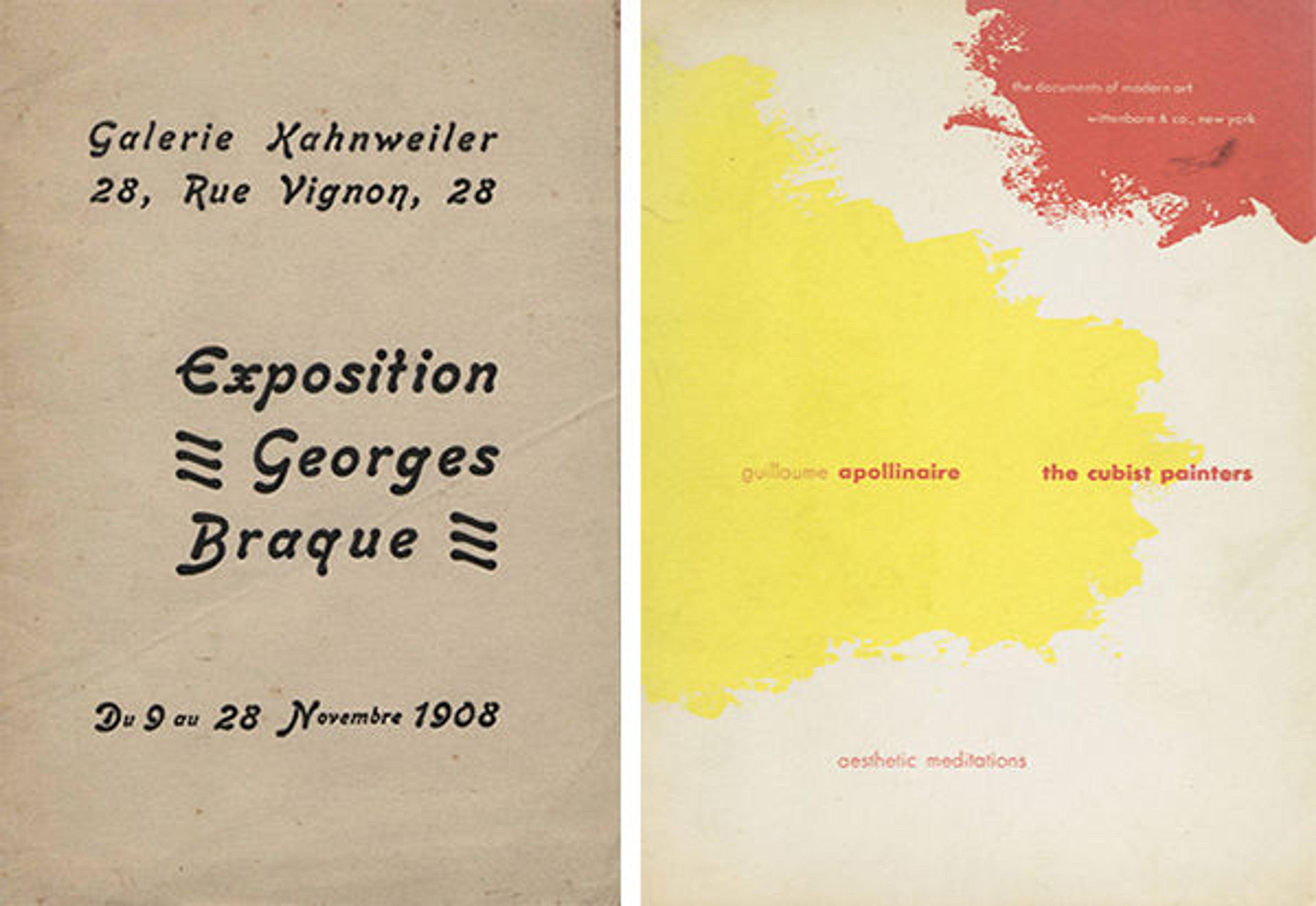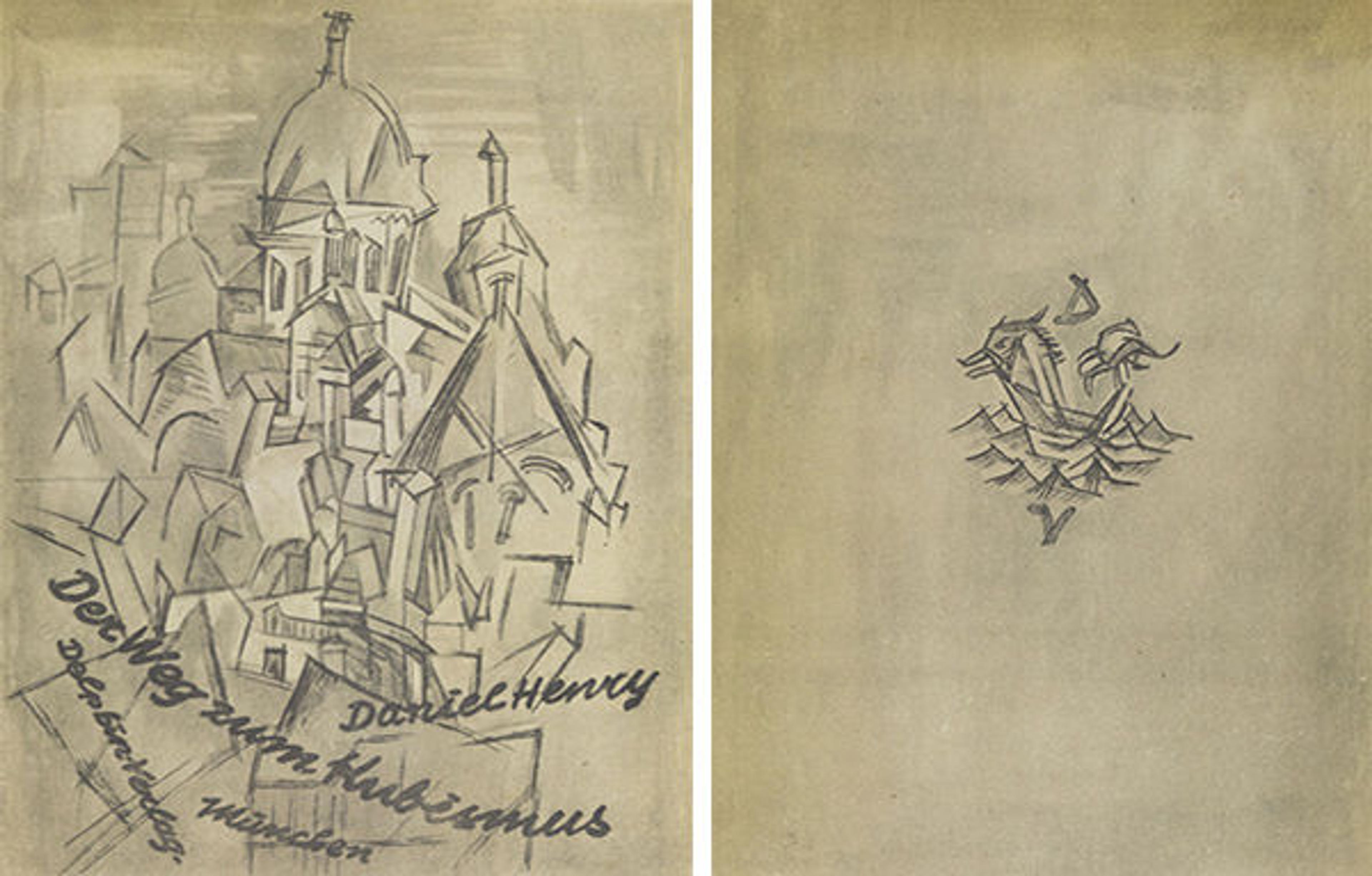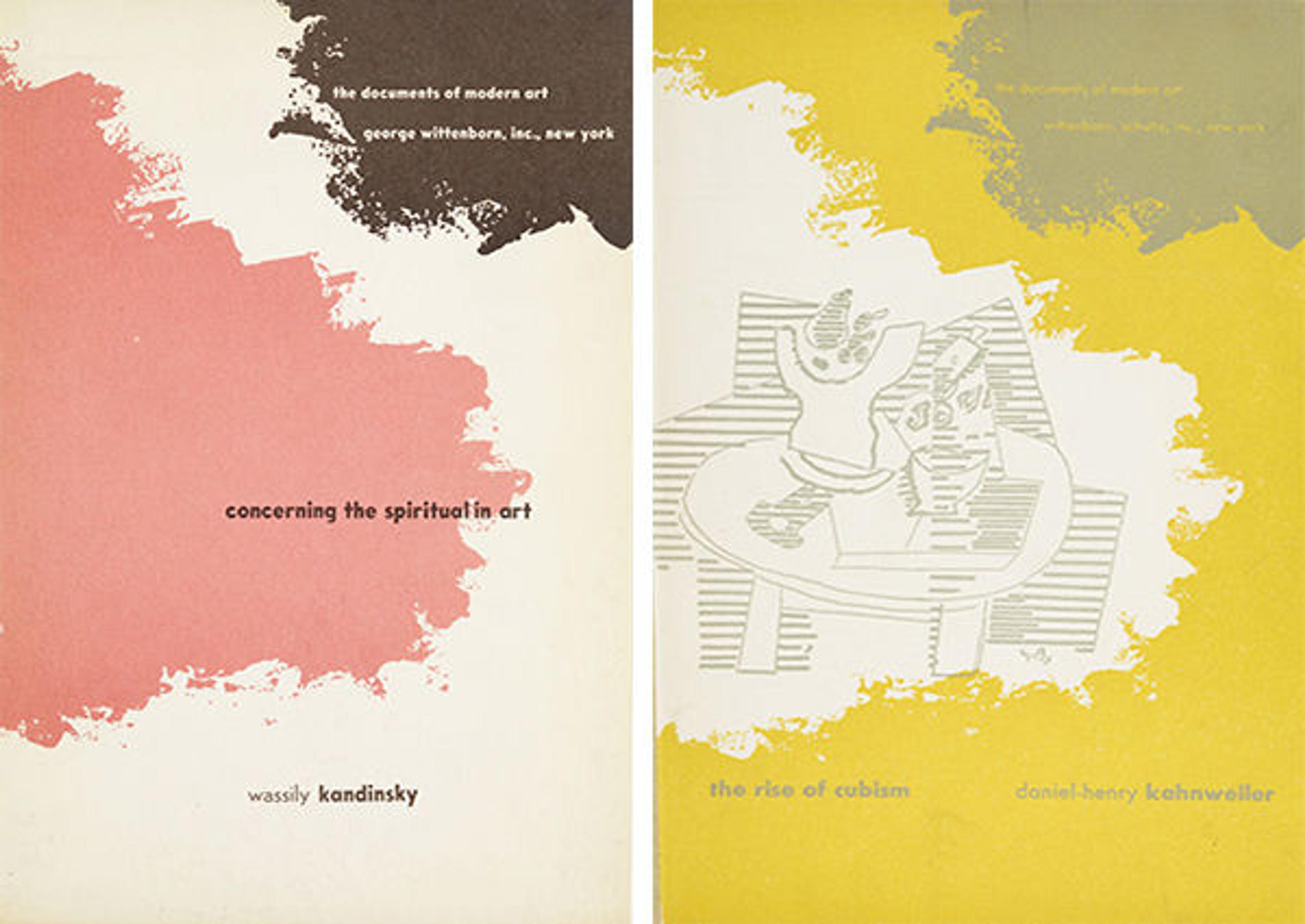
Left: Cover. Exposition Georges Braque: du 9 au 28 Novembre 1908. Paris: Galerie Kahnweiler, 1908. Right: Cover. Apollinaire, Guillaume. The Cubist Painters: Aesthetic Meditations, 1913. 1st ed. The Documents of Modern Art. New York: Wittenborn and company, 1944
«Have you ever looked at a work of art and thought to yourself, "What was the artist thinking?" How about an entire style or movement? Whether you are looking for theoretical enlightenment, practical guidance, or just a little context, the writings of artists, their supporters, and critics are valuable reference materials in the study of art. As the exhibition Cubism: The Leonard A. Lauder Collection nears the end of its run, it seems only fitting to take a moment to look to the Museum's libraries to explore our own collection of source materials regarding early Modern art.»
Watson Library's collection includes a large number of books related to Cubism and the artists who worked in the style. Some of the newest and most notable treasures in our special collections include a number of the earliest publications on the topic. The acquisition of these rare and valuable modern materials was made possible due to the generosity of the Friends of the Thomas J. Watson Library.

Left: Exhibition checklist. Exposition Georges Braque. Paris: Galerie Kahnweiler, 1908. Right: Georges Braque (French, 1882–1963). Trees at L'Estaque, 1908. Oil on canvas; 31 5/8 x 23 11/16 in. (80.3 x 60.2 cm). The Metropolitan Museum of Art, New York, Promised Gift from the Leonard A. Lauder Cubist Collection © 2014 Artists Rights Society (ARS), New York / ADAGP, Paris
One such publication is Exposition Georges Braque, an exhibition catalogue from what is considered to be the first Cubist exhibition, held at the Galerie Kahnweiler in Paris in 1908. Among the works included in the exhibition checklist are two paintings that are part of the Lauder Collection, Braque's La Terrace at the Hotel Mistral and Trees at L'Estaque (above right). Jack Flam's essay in the accompanying exhibition catalogue addresses these paintings in relation to the 1908 Galerie Kahnweiler exhibition. [1]

Left: A page from Apollinaire's essay. Right: Exhibition checklist. Exposition Georges Braque. Paris: Galerie Kahnweiler, 1908
In addition to a list of works exhibited, there is a brief essay by critic-poet Guillaume Apollinaire. Comparing these two pieces of the catalogue side-by-side (above), it is interesting to note the different typography employed. Apollinaire's essay and signature are rendered in font that could be considered Art Nouveau in style, while the publication information on the same page, as well as exhibition checklist, are produced in a more modern font. The entire exhibition catalogue is available online through our Digital Collections.
Apollinaire expanded upon the ideas presented in this essay in his 1913 publication Les Peintres Cubistes. In it, he discusses the historical beginnings of the style, as well as what he sees as the four main trends in Cubism. He also discusses a number of artists associated with it—in particular Pablo Picasso, Georges Braque, Juan Gris, and Fernand Léger.

Left: Cover. Apollinaire, Guillaume. Les Peintres Cubistes. Collection Tous Les Arts. Paris: Eugène Figuière et cie, éditeurs, 1913. Right: Cover. Gleizes, Albert, and Jean Metzinger. Du "Cubisme." 11 ed. Collection Tous Les Arts. Paris: Eugène Figuière et Cie, 1912
Eugène Figuière et Cie also published Albert Gleizes and Jean Metzinger's Du "Cubisme" (1912). Gleizes and Metzinger were part of the group of artists working in the style, and Du "Cubisme" is considered the first major treatise on the topic. Fortunately for those who do not read French, Watson also has a copy of the first English edition from 1913, which can be requested through Watsonline, or read online on the Hathi Trust website.
Both of these titles were published as part of a series called Collection Tous Les Arts. According to the back cover of Les Peintres Cubistes, this series consisted of practical guides for art lovers, collectors, and artists. While these books are significant as reference materials, the Watson special collections copies are also notable for their present state. At just over one hundred years old, Les Peintres Cubistes and Du "Cubisme" remain in excellent condition. Uncut pages along the top edges of both books suggest that neither has ever been read.

Left: Cover. Right: Back. Kahnweiler, Daniel-Henry. Der Weg Zum Kubismus. München: Delphin Verlag, 1920
Turning back to Daniel-Henry Kahnweiler, art dealer and owner of Galerie Kahnweiler, our special collections also include a copy of his 1920 publication Der Weg Zum Kubismus. The cover design features what appears to be a town rendered in a Cubist style, though the illustration does not seem to be attributed within the book. In keeping with the style of the cover, the back of the book includes an angular rendition of the publisher's logo, a dolphin or sea creature, accompanied by the initials "D V" for Delphin-Verlag. In addition to the three copies in the Museum’s libraries, this book can be read online through the Internet Archive.
Other noteworthy items in our collection include titles from a series called The Documents of Modern Art, founded and edited by artist Robert Motherwell and published by George Wittenborn. This series aimed to make texts written by modern European artists available in English at a modest price. The first volume in this series was The Cubist Painters, a translation of Apollinaire's Les Peintres Cubistes. Other books in the series include Piet Mondrian's Plastic Art and Pure Plastic Art (1945) and Wassily Kandinsky's Concerning the Spiritual in Art(1947) (below left).

Left: Cover. Kandinsky, Wassily. Concerning the Spiritual in Art, and Painting in Particular. 1912. [A Version of the Sadleir Translation. The Documents of Modern Art. New York: Wittenborn, Schultz, 1947. Right: Cover. Kahnweiler, Daniel-Henry. The Rise of Cubism. The Documents of Modern Art 9. New York: Wittenborn, Schultz, 1949
It was not until 1949 that Daniel-Henry Kahnweiler's Der Weg Zum Kubismus was translated into English. In fact, The Rise of Cubism, the ninth volume in the series (above right), was the first published translation of Kahnweiler's text into any language. Like many of the book covers in this series, it was designed by graphic designer Paul Rand and bears similarities to the covers of The Cubist Painters and Concerning the Spiritual in Art. You can read the digitized copy of The Rise of Cubism online on the Internet Archive.
For more information about the Leonard A. Lauder Collection of Cubist Art, check out the Museum's microsite for the Leonard A. Lauder Research Center for Modern Art.
[1] Flam, Jack, "The Birth of Cubism: Braque's Early Landscapes and the 1908 Galerie Kahnweiler Exhibition," in Cubism: The Leonard A. Lauder Collection, edited by Emily Braun and Rebecca Rabinow (New York: The Metropolitan Museum of Art, 2014), 22–27.